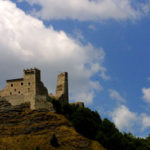 Località Varano
Località Varano
Da lassù i signori Da Varano potevano trarre vantaggi condizionando mercanti e viaggiatori che trafficavano tra il mare e Roma, ma la Rocca permetteva anche il controllo sulle linee di comunicazione con le basse valli del Chienti da cui la città ed il territorio traevano rifornimenti di grano. Rodolfo Gentile Da Varano, forse i suoi predecessori, i signori del sec. XV che continuarono saltuariamente ad abitarvi, ne tennero sempre il possesso. Finito il ducato divennero proprietari la camera apostolica, i Bandini e ora il comune di Camerino. La rocca è ora centro permanente dell’artigianato artistico e suggestiva sede di mostre, convegni e manifestazioni, oltre che meta di tanti visitatori.
Rocca Varano, fortress
The group of buildings dominated by Rocca Varano, symbol of a strong and glorious lordship, is perched on a rocky outcrop over the valley of Rio S. Luca and the narrow Chienti river valley. The fortress bears the signs of its long history until it was registered as a mere ‘country dwelling’ at the beginning of the last Century. The cut for its drawbridge, the only access to the rock on which it stands, is still visible. The entrance door in white stone, with a pointed arch, was positioned sideways to the bridge for defensive reasons. Beyond a small courtyard were the rooms belonging to the Lord, with arched, panelled ceilings. An imposing subterranean structure with an arched ceiling probably with rooms above which would have been flanked by towers, would have connected this wing to the one on the river side. Possession of the fortress allowed the da Varanos to oversee communications with the lower Chienti valley, from which the town and surrounding areas imported grain. Rocca Varano is now a centre for arts and crafts and is an impressive centre for exhibitions, congresses and events of all kinds.

